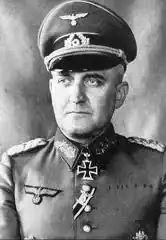Johann-Georg Richert | |
|---|---|
 | |
| Born | 14 April 1890 |
| Died | 30 January 1946 (aged 55) |
| Cause of death | Execution by hanging |
| Criminal status | Executed |
| Motive | Nazism |
| Conviction(s) | War crimes |
| Trial | Minsk Trial |
| Criminal penalty | Death |
| Military career | |
| Allegiance | |
| Years of service | 1909–45 |
| Rank | Generalleutnant |
| Commands held | 286th Security Division 35th Infantry Division |
| Awards | Knight's Cross of the Iron Cross with Oak Leaves |
Johann-Georg Richert (14 April 1890 – 30 January 1946) was a German general during World War II. He commanded the 286th Security Division whose personnel committed numerous war crimes in occupied Belarus, in the Army Group Center Rear Area.
The 35th Infantry Division also committed war crimes during early 1944 while Richert was its commanding officer. The division's operations against "partisans" (who were often civilians) became more frequent and brutal after Richert assumed command.[1] Richert also ordered that all of his soldiers who were in hospitals without injuries or a diagnosed illness be executed, and threatened units and commanding officers who were defeated in battle with severe penalties.[2]
With the help of troops from Sonderkommando 7b of Einsatzgruppe B, Richert forced at least 40,000 civilians into the Ozarichi death camps, makeshift camps which had been established by Josef Harpe. Dieter Pohl has called the establishment of the camp "one of the worst crimes the Wehrmacht ever committed against civilians".[3][4] By the time troops of the 65th Army of the First Belorussian Front liberated those in camps on 19 March 1944, at least 9000 people had died. The troops freed 33,480 people, including 15,960 children under the age of 13, from the Ozarichi deaths camps.[5]
Richert was taken prisoner by Soviet troops on 8 May 1945. In 1946, he was put on trial by a Soviet military court in Minsk for his role in the deportations, as well as other crimes against Soviet civilians. Richert was sentenced to death, and publicly hanged the next morning in Minsk on 30 January 1946. Richert was hanged with 13 of his codefendants with over 100,000 people watching.[6]
Awards and decorations
- Clasp to the Iron Cross (1939) 2nd Class (20 September 1939) & 1st Class (3 October 1939)[7]
- German Cross in Gold on 1 December 1941 as oberst in 23rd Infantry Regiment[8]
- Knight's Cross of the Iron Cross with Oak Leaves
- Knight's Cross on 17 March 1944 as generalleutnant and commander of 35th Infantry Division[9]
- Oak Leaves on 18 October 1944 as generalleutnant and commander of 35th Infantry Division[10]
References
Citations
- ↑ Wildermuth 2019, pp. 1210–1211.
- ↑ Wildermuth 2019, p. 1197.
- ↑ "Useless Mouths". www.german-foreign-policy.com. Retrieved 2022-09-16.
- ↑ "Holocaust in Belorussia [Pages 67-86]". www.jewishgen.org. Retrieved 2022-09-16.
- ↑ Rass & Rohrkam, Christoph & René. "The Concentration Camps near Ozarichi" (PDF).
- ↑ "Generaloberst Josef Harpe - Lexikon der Wehrmacht". www.lexikon-der-wehrmacht.de. Retrieved 2022-09-16.
- ↑ Thomas 1998, p. 204.
- ↑ Patzwall & Scherzer 2001, p. 376.
- ↑ Fellgiebel 2000, p. 290.
- ↑ Fellgiebel 2000, p. 76.
Bibliography
- Fellgiebel, Walther-Peer (2000) [1986]. Die Träger des Ritterkreuzes des Eisernen Kreuzes 1939–1945 [The Bearers of the Knight's Cross of the Iron Cross 1939–1945] (in German). Friedberg, Germany: Podzun-Pallas. ISBN 978-3-7909-0284-6.
- Heer, Hannes (2004). "The Logic of the War of Extermination". In Hannes Heer; Klaus Naumann (eds.). War of Extermination: The German Military In World War II. Berghahn Books. ISBN 1-57181-232-6.
- Patzwall, Klaus D.; Scherzer, Veit (2001). Das Deutsche Kreuz 1941 – 1945 Band II [The German Cross 1941 – 1945 Volume 2] (in German). Norderstedt, Germany: Verlag Klaus D. Patzwall. ISBN 978-3-931533-45-8.
- Thomas, Franz (1998). Die Eichenlaubträger 1939–1945 Band 2: L–Z [The Oak Leaves Bearers 1939–1945 Volume 2: L–Z] (in German). Osnabrück, Germany: Biblio-Verlag. ISBN 978-3-7648-2300-9.
- Wildermuth, David W. (October 2019). ""I am fully aware of my guilt...": Insights from a Soviet Military Tribunal's Investigation of the German Army's 35th Division, 1946-47". The Journal of Military History. 83 (4): 1189–1213.
Further reading
- Beorn, Waitman Wade (2014). Marching into Darkness: The Wehrmacht and the Holocaust in Belarus. Cambridge: Harvard University Press. ISBN 978-0674725508.